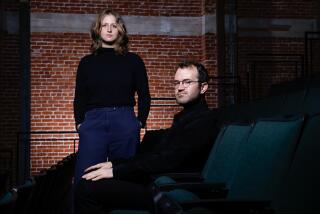Long Beach Festival Takes the Wide View of Screen Gems
From “Fiddler on the Roof” to Jackie Chan’s latest Hong Kong action movie, this year’s WideScreen Film Festival offers a wide (pardon the expression) variety of genres, beginning tonight at the Carpenter Performing Arts Center in Long Beach.
The fifth annual festival, which features films shot in wide-screen format (Panavision or CinemaScope) and projected at full horizontal frame rather than clipped on the sides, gets underway with “Fiddler,” the 1971 musical that still maintains its appeal. It wraps Sunday with a tribute to “Chinatown,” which remains exquisitely fascinating 25 years after its initial release. “Chinatown” screenwriter Robert Towne and cinematographer John Alonzo are scheduled to attend and, before the screening, participate in a discussion moderated by Time magazine film critic Richard Schickel.
The festival will also honor legendary movie composer Elmer Bernstein on Sunday with a screening of one of his best-known films, “The Great Escape,” the immensely popular 1963 POW action-adventure that only improves with age.
The 73-year-old composer will be on hand to discuss his 49-year career, which includes such delights as ‘The Magnificent Seven,” “To Kill a Mockingbird” and “The Man with the Golden Arm.” His latest in a string of more than 200 scores is “Bringing Out the Dead,” the Martin Scorsese drama that opens Friday.
The composer has the highest regard for “The Great Escape” and its underrated director, the late John Sturges. “A lot happens in the music because of John,” Bernstein concedes. “He was unique. He wouldn’t let you read the script. He’d call you in and tell you the story in an hour or more. He was an amazing storyteller. If you had any sensitivity at all, you were inspired.
“ ‘The Great Escape’ displays an odd combination of courage and humor--a kind of striving and a great deal about spirit. And the music has the right jaunty spirit. The lightness stems from Steve McQueen’s performance. A sadder moment, the tender relationship between James Garner and Donald Pleasance, had a great influence on me. You live with a film in your imagination, and you begin to develop relationships with the characters.”
And we’ve developed relationships with some of these wide-screen classics as well. A brand new print of “Mad Max,” which propelled Mel Gibson to stardom 20 years ago, screens Friday night with its original Australian track, while the traditional late-night screening is still unconfirmed. It will be either Russ Meyer’s notorious “Beyond the Valley of the Dolls” or John Carpenter’s campy “Big Trouble in Little China.”
Speaking of cult classics, Disney’s overlooked “Tron,” hailed for its trailblazing computer-generated imagery if not for much else, screens Saturday afternoon. Then the theatrical debut of Jackie Chan’s newest Hong Kong martial-arts farce, “Gorgeous,” screens Saturday evening, followed by the best of the Blake Edwards’ Inspector Clouseau films, “A Shot in the Dark.”
But it’s the new print of “Chinatown” that should attract the most wide-screen die-hards. The intricate murder-mystery about L.A. in the 1930s, starring Jack Nicholson and Faye Dunaway, arrived at just the right time--in 1974. It was like a brilliant bridge between the past and the present, revealing how the absolute power of corruption knows no bounds. The tense collaboration between screenwriter Towne and director Roman Polanski--they weren’t on speaking terms by the time shooting began--enhanced the film’s mythic power.
“There’s something that happens to young filmmakers--a fear that makes you question whether you’re doing the right thing,” suggests Alonzo, cinematographer of “Chinatown.”
“We were all uncertain about how it would turn out, but we took risks and we trusted our instincts. I’d say we made the right choices.”
Alonzo, who was a last-minute replacement for veteran Stanley Cortez, stepped in and immediately delivered what Polanski required. “He said, ‘Johnny, please no diffusion on the lens--I don’t want a Hollywood look.’ So I borrowed an idea that the great Jimmy Wong Howe had told me about. I used Chinese tracing paper to shift the light and color so that it turned beige and gold. Roman liked it. Dick Sylbert’s art direction really suggested the lighting style.”
Bridging the past and present is what the festival is all about. It appeals to a diverse audience in Long Beach, while still attracting a sizable number of filmgoers beyond. For the past couple of years, however, the festival has had trouble sustaining momentum beyond one weekend, which is why the organizers have retrenched from a more ambitious multi-weekend approach.
“This year we’re shorter and sweeter,” says founder and artistic director Gary Prebula. “It’s more manageable. The plan is to eventually retool the festival for one straight week.”
Meanwhile, the Carpenter Center’s growing commitment to film has resulted in three new spinoffs: a monthly Friday Night at the Movies program, beginning next month with “The Russians Are Coming, the Russians Are Coming!,” a Japanese animation festival to be held April 21-22 and a cinema society to feature more classics and cutting-edge films in the center’s 1,065-seat stadium-style theater.
“We’re learning more and more what Long Beach wants to see,” Prebula adds. “And it’s musicals, sci-fi, classics, animation, premieres--and John Carpenter movies.”
BE THERE
Fifth annual WideScreen Film Festival. Through Sunday at the Carpenter Performing Arts Center, 6200 Atherton St., Long Beach. (562-985-7000).
More to Read
Only good movies
Get the Indie Focus newsletter, Mark Olsen's weekly guide to the world of cinema.
You may occasionally receive promotional content from the Los Angeles Times.










